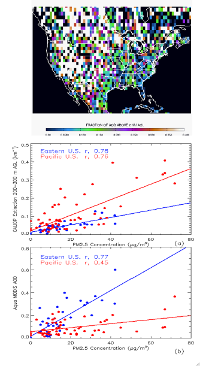Impact of Data Quality and Surface-to-Column Representativeness on the PM2.5/Satellite AOD Relationship for the Continental United States

Satellite-derived aerosol optical depth (AOD) observations have been used to estimate particulate matter less than 2.5 µm (PM2.5). However, such a relationship could be affected by the representativeness of satellite-derived AOD to surface aerosol particle mass concentration and satellite AOD data quality. Using purely measurement-based methods, we have explored the impacts of data quality and representativeness on the AOD inferred PM2.5/AOD relationship for the Continental United States (CONUS). This is done through temporally and spatially collocated datasets of PM2.5 and AOD retrievals from Aqua/Terra Moderate Resolution Imaging Spectroradiometer (MODIS), Multi-angle Imaging Spectroradiometer (MISR), and Cloud-Aerosol Lidar with Orthogonal Polarization (CALIOP). These analyses show that improving data quality of satellite AOD, such as done with data assimilation-grade retrievals, increases their correlation with PM2.5. However, overall correlation is relatively low across the CONUS. Also, integrated extinction observed within the 500 m above ground level (a.g.l.), as measured by CALIOP, is not well representative of the total column AOD. Surface aerosol in the Eastern CONUS is better correlated than in the Western CONUS. The best correlation values are found for estimated dry mass CALIOP extinction at 200-300 m a.g.l. and PM2.5, but additional work is needed to address the ability of using actively sensed AOD as a proxy for PM2.5 concentrations.